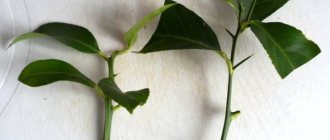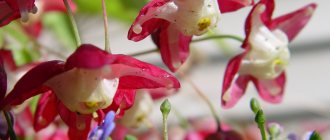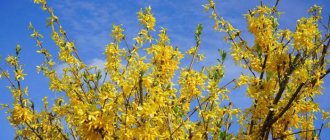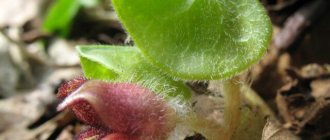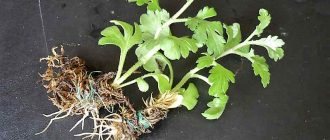A brief introduction to the wild lemon poncirus
Wild lemon or poncirus is a shrub from the genus citrus, with light green, shiny leaves and the same pale green branches, up to 6 m high. The tree also has fruits, they are round, up to 4 cm in diameter, at first grayish-green , and when they ripen, their skin turns yellow. The peel of wild lemons is thicker and rougher than that of its cultivated relatives.
Inside, the poncirus fruit has a sour taste, like a regular lemon, but it is more bitter, there is less pulp than in a cultivated lemon, and there are many seeds.
Wild lemons grow thorns along with leaves on their branches, so the bushes can also be planted instead of a hedge.
Wild lemon blooms in April-May with white flowers with a strong citrus aroma. The flowering time lasts a long time, up to 2 months.
In the wild, the plant lives up to 100 years.
This is how wild lemon blooms
The wild lemon will sing
Botanical description
Poncirus is a small deciduous tree with many trunks. Its height does not exceed 5 meters. The plant has a spreading, tent-shaped crown. The trunks have beautiful, light green bark; young shoots are green in color, distinguished by their flattened shape and the presence of spines.
The location of the spines is the axils of the foliage, their length is approximately 5 cm. The foliage is 10-12 cm long, trifoliate. The petioles have shiny leaves that are pale green in color.
The plant has white flowers, the diameter of which is 5 cm. They have a strong lemon aroma and bloom even before the leaves appear. The fruit has a round shape, the ripe fruit is bright yellow, there is a hairy, aromatic crust on top, and inside there is bitter, oily, inedible pulp mixed with a large number of seeds.
The top layer of the fruit has its own name - flavedo . It contains many glands that secrete essential oils. The inner layer is called albedo and has a spongy structure. The plant begins to bloom and bear fruit only from 4-5 years.
Beneficial properties of wild lemon poncirus
Wild lemon is a very useful vitamin product. In addition to vitamins A, C, E, PP, poncirus contains the following B vitamins: B1, B2, B5, B6, B7. Wild lemon is also rich in:
- Potassium
- Gray
- Calcium
- Chlorine
- Phosphorus
- Magnesium
- Zinc
- Iron
- Fluorine
Rare microelements:
- Molybdenum
- Borom
- Copper
Wild lemon in cross section
What diseases does wild lemon poncirus help treat?
What does wild lemon cure?
- Consuming fruit with tea improves immunity
- Chewing wild lemon peel restores microflora in the mouth and pleasant breath, whitens teeth
- Wild lemon juice removes age spots, pimples and redness from facial skin
- Eating a slice of wild lemon relieves heartburn
- Constant consumption of at least a small amount of poncirus increases hemoglobin and cleanses the blood of toxins
- If you often eat wild lemon, you will not experience constipation or diarrhea.
- Wild lemon contains B vitamins, which are important for good, restful sleep.
- Regular consumption of wild lemon, even in small quantities, will improve your blood pressure.
- By eating wild lemon, you remove unnecessary cholesterol from your body, speed up your metabolism and look younger.
- Poncirus is rich in calcium, which is so beneficial for our bones and joints
Benefit: medicinal properties
Let's consider what effect wild lemon can have on the human body.
- Immunity . Eating fruit helps to increase the body's defenses and saturate it with ascorbic and folic acid. As a result, the risk of developing colds is significantly reduced.
- Teeth . Thanks to the acids and oils contained in lemon, your breath will be fresh and the microflora in your mouth will be restored, which prevents the appearance of caries. In addition, lemon juice helps whiten tooth enamel.
- Leather _ Wild lemon allows you to get rid of acne in a short period of time, eliminate violations of the integrity of the skin, remove pimples and age spots. Lemon juice rejuvenates, regenerates and soothes the skin.
- Stomach . Eating the fruit will help you get rid of heartburn, which often appears when the level of acidity in the stomach increases. Food will be digested faster, and all “waste” will be dissolved.
- Blood . Eating poncirus helps cleanse the blood of toxins and improves blood circulation through the veins. In addition, the fruit increases hemoglobin.
- Heart . The fruit has low calorie content and is rich in fiber, which helps cleanse the intestines of toxins, and this prevents the development of obesity, which in most cases leads to cardiac diseases.
- Intestines . Since the composition contains dietary fiber and a large amount of water, the removal of harmful substances is accelerated, which allows you to quickly cope with constipation or diarrhea.
- Dream . Poncirus is rich in B vitamins, which are necessary for healthy, full sleep. And sleep promotes good mood, high performance and vigor.
- Pressure . Regular consumption of the fruit in moderate dosages allows you to normalize blood pressure and get rid of migraine attacks and dizziness.
- Youth . The composition of poncirus helps remove cholesterol from the body and accelerate cell regeneration. As a result, the aging process slows down and wrinkles are smoothed out.
- Bones . Wild lemon contains a large amount of calcium, so your joints and bones will always be healthy.
Where can wild lemon poncirus grow?
Poncirus grows in wild thickets in South Asia, but it can also be planted in countries with a temperate climate, because it can withstand temperatures down to 20-25 degrees below zero in winter. If the temperature in your area rises higher in winter, the tree will have to be covered for the winter.
Wild lemon is unpretentious, grows on any soil, survives if the soil around it is not loosened, but is sun-loving, and should be planted on the sunny side. There is no need to water it additionally, except for rain, except when there has been no rain for a month or more, then water it once a week.
This is how wild lemon bushes grow
Wild lemon and yogo photo
The native land of wild lemon is India and Eastern China, where the growing area is much wider. Cultivated in Western Asia, Latin America, Japan.
Related article: Adansonia description and features
The tree is light-loving. Frost-resistant, tolerate frosts down to -25 ° C. It is not possible for the minds to grow. Provides benefits to deep, well-formed, fluffy, slightly acidic substrates. The first 3 rivers achieve full growth, the 4th river gives a significant increase, up to 40 cm per season. The average triviality of life is 100 fates.
Propagate Danish citrus with live bait and plants. With the current method of propagation, the traces must be preserved, but if the seeds are carefully preserved, their similarity decreases. The similarity of fresh meat reaches up to 90% or more.
Do not be surprised that the fruits of the ponzirus are natural, they do not survive through the pulp of the hot essential oil.
Use wild lemon as a substitute for other citrus crops. Zastosovuetsya for the creation of living flesh.
A photo of wild lemon is presented in the gallery below:
How to plant wild lemon poncirus from seeds?
- Soak poncirus seeds for 5-6 hours along with a growth stimulator (succinic or boric acid, “Heteroauxin”).
- Plant the seeds in moist soil to a depth of 0.5-1 cm.
- Cover the pot with film and place it in a bright room with a temperature of 23-28 degrees Celsius.
- After 7-10 days we check the seedlings.
- You can replant the ascended plant into another pot or into open ground only after 3 months.
Wild lemon poncirus grows slowly for the first 2-3 years after germination, in the 4th year it begins to grow quickly (up to 50 cm per year), bears fruit in 4-5 years.
Growing and sowing at home
Let's look at how to properly grow wild lemon at home.
Sowing and propagation
The most common practice is to grow a tree from seeds. This is done as follows:
- first you need to soak the seeds in water, add growth stimulants to the liquid;
- leave for 5-6 hours;
- moisten the soil intended for planting;
- sow the seeds in loosened, light soil, deepening them by 0.5-1 cm;
- cover the crops with film, place the container in the light in a room with a temperature of +23. +28 °C;
- After 7-10 days, check whether seedlings have appeared.
It is worth noting that picking is not carried out until 3 months, so before sowing it is worth preparing appropriate containers.
Sometimes propagation is carried out by cuttings. To do this, it is necessary to select cuttings whose height should be at least 10 cm; it is better to do this in spring or summer. When using this method, you cannot do without the use of growth hormones. To do this, the cuttings are covered with a plastic cap, the drug is added to the soil and planted after 6-8 weeks.
Soil and fertilizer
The tree can adapt to any soil, but it is better to plant the plant in loose and moderately moist soil. There is no need to carry out the procedure of loosening the tree trunk circle. It’s good if there is peat, leaf humus, perlite or vermiculite in the soil - this will improve drainage. Only mature plants need to be fed in the spring. For this, organic fertilizers are used.
Watering and humidity
If the air in the room is dry, it is necessary to humidify it or place the tree on a tray with moistened pebbles. You need to make sure that the water does not come into contact with the bottom of the pot. Also, if there is dry air in the room, it is recommended to spray the foliage with warm water. It is better to place the poncirus in a room that is well ventilated, but drafts should be completely excluded.
The soil should be evenly moist, but it should not become swampy. Water when the top layer is 3.5 cm dry. In autumn, watering should be reduced.
It is recommended to prune damaged and dried shoots in early spring. The plant tolerates both pruning to form a crown and sanitary procedures. To form the correct and beautiful height of the crown, it is necessary to trim its third part.
Wintering and frost resistance
When growing plants at home, people often place them on the windowsill. With the arrival of winter, the question arises about whether the temperature near the window is comfortable for living, because it is lower there than in the entire apartment. There is no need to worry about this, since the poncirus tolerates low temperatures well, it will not freeze and will not start to get sick.
Sometimes in autumn, the owners of the plant take it out onto a glassed-in balcony, because the plant tolerates coolness well, even at a temperature of +8. +12 °C will feel very comfortable.
If wild lemon is grown outside, you also don’t have to worry about it when winter comes. The plant has good frost resistance and can withstand frosts down to -15. -20 °C. If the tree is grown in harsh winter conditions, then it is worth covering it with spruce branches or non-woven material for the winter.
Procurement of raw materials
To use a plant for medicinal purposes, all its parts are harvested. Stems, leaves and fruits must be collected during the flowering period, but seeds - when they are most ripe. The stems and leaves are collected by hand, after which they should be laid out on cardboard or cloth and dried outside.
The fruits should be washed, cut, seeds removed and dried in the sun. After the fruits have dried, they should be poured into a glass container and stored for 1 year.
Diseases and pests
Like all citrus fruits, poncirus is susceptible to attacks by the exocortis virus. They manifest themselves in damage to the plant bark, chlorosis of leaves, increased branching of shoots, which gradually leads to its death.
Do not allow the soil to dry out, as this can cause the leaves to curl and fall off. Violation of watering rules also leads to yellowing of the foliage.
If you notice that the leaves have become pale, this indicates a lack of fertilizer. Lack of flowering indicates the pot size is too small or there is not enough sunlight.
In the presence of dry air, the plant is often attacked by scale insects and mites. A characteristic sign of a scale insect attack is brown plaques on the foliage. Over time, the leaves will turn pale and fall off, and the flowers and fruits will dry out. In order to get rid of this pest, you will have to treat it with special insecticidal preparations.
If the foliage becomes limp and cobwebs begin to appear in the internodes, this indicates that a spider mite has settled on the tree. If the damage is minor, it is enough to wash the tree with a soap solution. If the situation is more complex, it is worth spraying the plant with insecticides.
In addition, young plants are often attacked by mealybugs, and whiteflies can settle on the underside of the foliage. Unfortunately, citrus plants are often subject to fungal attacks, resulting in damage to the rhizome, trunk, branches, leaves and fruits.
Poncirus trifolia is a wild but very useful plant. However, before using it for medicinal purposes, you should definitely consult with your doctor. You can grow a tree without much difficulty at home.
What diseases can wild lemon poncirus get?
Wild lemon poncirus is more resistant to diseases than cultivated lemons, but it still gets sick sometimes. What diseases are these?
- Viruses. Symptoms: damaged tree bark, yellowing leaves, very dense shoots on the tree.
- Drying out the soil leads to yellowing, curling and falling of leaves.
- Lack of fertilizer - pale leaves.
- , mites and scale insects can attack the tree Signs: brown plaques appear on the leaves, then these leaves dry out and fall off. (The tree is treated with insecticidal preparations).
- Spider mite - the leaves are limp and covered with cobwebs. At first, if there are few ticks, spraying with a soap solution helps, but if the onset of the disease is missed, you need to treat with insecticides.
- Mealybugs and whiteflies can also attack the plant
- Wild lemon, just like cultivated lemon, although much less frequently, can develop fungal diseases.
Harm and contraindications to consuming wild lemon
Since this fruit is a citrus fruit, you shouldn’t eat too much of it, especially, you don’t need to do it on an empty stomach, in the morning - before that it’s better to drink a little water or eat something. The best option is to add it to tea or any dishes.
It is also not recommended to give large amounts of lemon to children, since they are most susceptible to allergic reactions. Ideally, after consuming it, you should brush your teeth so that citric acid does not dissolve their enamel.
The following contraindications to wild lemon should be noted:
Stomach and duodenal ulcers
. With these diseases, the integrity of the mucous membrane is disrupted, it loses its elasticity and becomes covered with numerous large or small follicles. When the walls of these organs are irritated by fruit juice, their number only increases.
Colitis and gastritis
. Outside the acute stage, you can afford to add a slice of lemon to tea or any dishes. But under no circumstances should you eat it in its pure form, especially without sugar. This can lead to severe abdominal pain and even bleeding.
Cholecystitis
. With this disease, you should not eat anything spicy, sweet or sour. Lemon is one of the last fruits, loading the already diseased gallbladder.
. We are talking about sore throat, pharyngitis, tonsillitis, hypertrophy of the lingual and palatine tonsils, laryngitis, tracheitis, bronchitis. With such problems, the oral mucosa is covered with small ulcers and needs gentle food, but the acids contained in lemon will irritate it.
The essential oils contained in the fruit can cause numerous pimples to appear on the skin.
How is wild lemon poncirus used in households and folk medicine?
In official medicine there is no use for the fruits of the wild lemon poncirus, but traditional medicine uses the entire plant:
- Ripe fruits are used in cooking and perfumery.
- Stems, leaves, peel, seeds, and even roots in the East, where wild lemon grows in thickets, are used to produce essential oil.
- And even unripe fruits help: With stomach upsets Have diuretic properties Improve lactation for young mothers
- Dried wild lemon peels, folded in a small linen bag, will fill a room or closet with bed linen with a pleasant aroma.
Chemical composition
Poncirus fruits contain light yellow essential oil and contain sugar.
Also includes:
- galacturonic acid;
- vitamins A, B, C;
- limonene, cadinene;
- coumarins;
- flavonoids;
- pectins.
The seeds contain a large amount of fatty oil, the peel is rich in vitamins P and C. Essential oils are also present in the stems and leaves of the plant.
Lemon roll with wild lemon poncirus: recipe
Let's take the roll:
- 3 tbsp. l. butter
- 150 ml milk
- 3 eggs
- 150 g sugar
- 2 cups of flour
- 1 tsp. store bought baking powder
- Zest of 1 wild lemon poncirus
To grease the crust:
- 0.5 cans of condensed milk
Cooking:
- Mix milk with butter and heat until dissolved, let cool slightly.
- Beat the eggs with sugar with a mixer until they increase 3 times.
- Pour milk and butter into the eggs, mix, gradually add flour mixed with baking powder and lemon zest, and knead from bottom to top. Add enough flour to make a slightly runny dough. It is possible that not all the flour will work.
- Line a rectangular pan with parchment paper, pour in the dough, and bake in an oven preheated to 200 degrees for about 20 minutes.
- We take out the baked hot cake along with the parchment, grease the top with condensed milk, and carefully separate the paper from the cake and roll it into a roll.
Roll with wild lemon zest added to the dough
Features of cultivation
If you have decided to grow such an exotic plant in your garden, then you should familiarize yourself with some of the features of its planting and maintenance.
Choosing a landing site
Like any member of the Citrus family, trifoliata loves to grow in a sunny area, where there are no winds or drafts. Good lighting is the key to lush flowering and abundant fruiting of the shrub.
Three-leaved poncirus grows on almost all types of soil, but prefers light, loose and slightly moist soil with a low acidity level. During the growing process, no soil loosening procedure is carried out for this plant. Choose an area with deep groundwater to eliminate the risk of root system rotting.
Landing
For planting, it is better to use annual seedlings from the nursery, since independent propagation of this plant is not always successful.
A nutrient mixture of wood ash (100 g), superphosphate (40 g) and garden soil is poured into a dug hole 70 cm deep and 80 cm wide. The root system is laid on top, leveled, sprinkled with earth and watered abundantly.
Gardeners often grow this tree at home, and after a few years they transplant it into open ground. In this case, you will need a large pot with drainage holes. The optimal dimensions of the container are 50x40 cm. For planting at home, you can use the same mixture as for plants in open ground.
Marinade for shashlik with the addition of wild lemon poncirus: recipe
This marinade is enough for 1 kg of meat.
Let's use the marinade:
- 30 ml dry red wine
- 2-3 medium onions
- 5 cloves garlic
- Salt to taste
- Pinch of nutmeg
- Juice from 6 wild poncirus lemons
Cooking:
- Cut the onion into thick rings.
- Finely chop the garlic cloves.
- Add chopped garlic to the onion half rings, add salt to taste, sprinkle with nutmeg, and squeeze out the juice from wild poncirus lemons.
- Dip the meat cut into kebabs into the marinade and marinate for about 2 hours, then thread the meat onto a skewer, alternating it with onions.
Shish kebab marinated with wild lemon juice
Practical use
The fruits are used in cooking
Wild lemon has found application in various fields.
Cooking
The fruits are used in a similar way to classic citrus, including in cooking as a seasoning and in the preparation of sweet dishes and baked goods. After heat treatment, it is consumed in its pure form. Due to the high content of bitter essential oil, wild lemon cannot be consumed without heat treatment.
Gardening and landscape design
Wild lemon is used for vegetative propagation of varietal varieties of lemons during the grafting process as a rootstock.
In landscape design, the plant is grown as a hedge.
ethnoscience
The fruit is widely used to treat a number of diseases.
Immunity
The plant saturates the body with ascorbic and folic acids, organizes normal hematopoiesis and increases resistance to colds.
Organic acids and essential oils act as agents for fresh breath and restoration of oral microflora, slow down the development of caries, have whitening properties, and are included in many toothpastes.
Skin covering
Wild lemon is an effective remedy for treating the epidermis, including acne, increased dryness and flaking. It also promotes cell regeneration.
The fruit neutralizes increased acidity, promoting the activation of digestive processes, and breaks down undigested food residues. Thanks to the dietary fiber contained in the composition, it is useful for colitis and rectal ulcers.
Blood vessels
Lemon cleanses the blood of toxins, increasing blood circulation through the vessels, and increases hemoglobin levels.
Heart muscle
The plant prevents the development of fat cell deposition, which adversely affects the normal functioning of the heart muscle.
Bone
Lemon acts as a source of calcium, replenishing its deficiency in bone tissue, reducing the risk of joint diseases.
Wild lemon is the fruit of a plant belonging to the Rutaceae family and the Citrus genus. Outwardly, it looks like an ordinary lemon cultivated on plantations. The fruits grow on trees 2 to 5 m high, have a bright yellow color, oval shape and a rough surface. They reach 6-7 cm in length and 3-4 cm in width. Their taste is bitter and sour, the flesh is very juicy, and the seeds are quite large. The plant is native to India, where it is found wild in forests. There is extensive experience in its cultivation in the subtropics, mainly in the countries of South Asia (Bangladesh, Pakistan, Cambodia), as well as in Latin America (Ecuador, Brazil, Peru, Venezuela). In cooking, these fruits are used as a cut for the festive table and as an additive to tea, for preparing various sweets and baked goods. They are eaten both in pure form and after heat treatment.
Candied wild lemons: recipe
Let's take candied fruits:
- 1 kg wild lemons poncirus
- 1.5 kg sugar
- 800 ml water
Cooking:
- We cut the washed poncirus lemons into thin slices, take out the seeds and throw them away, they are not needed here.
- Place the lemon slices in a large, thick-walled saucepan, pour sugar on them, and leave for 20 minutes.
- Then fill the slices with water and put them on the stove to simmer over low heat for about 4 hours. Don't forget to stir.
- When the lemon slices have cooled in the syrup, you can remove them from it, arrange them one at a time, and dry them.
Candied wild lemons
Lemon wild
Wild lemon is the fruit of a plant belonging to the Rutaceae family and the Citrus genus. Outwardly, it looks like an ordinary lemon cultivated on plantations. The fruits grow on trees 2 to 5 m high, have a bright yellow color, oval shape and a rough surface. They reach 6-7 cm in length and 3-4 cm in width. Their taste is bitter and sour, the flesh is very juicy, and the seeds are quite large. The plant is native to India, where it is found wild in forests. There is extensive experience in its cultivation in the subtropics, mainly in the countries of South Asia (Bangladesh, Pakistan, Cambodia), as well as in Latin America (Ecuador, Brazil, Peru, Venezuela). In cooking, these fruits are used as a cut for the festive table and as an additive to tea, for preparing various sweets and baked goods. They are eaten both in pure form and after heat treatment.
Homemade limoncella from wild poncirus lemons: recipe
Let's use limoncello:
- Zest from 0.5 kg of wild poncirus lemons
- 0.5 kg sugar
- 1 liter of vodka
- 700 ml water
Cooking:
- Using a fine grater, remove the zest from wild lemons washed in warm water and dried.
- Pour the zest into a jar, fill it with vodka, and place it in a cold place for 2 days.
- Dissolve sugar in hot water.
- Separate the vodka from the zest: strain it through cheesecloth.
- Pour the syrup into the vodka, pour the resulting limoncella into bottles, cap them, leave for 3 months, and you can try.
Wild Lemon Limoncella
So we've learned a little more about wild lemons.
